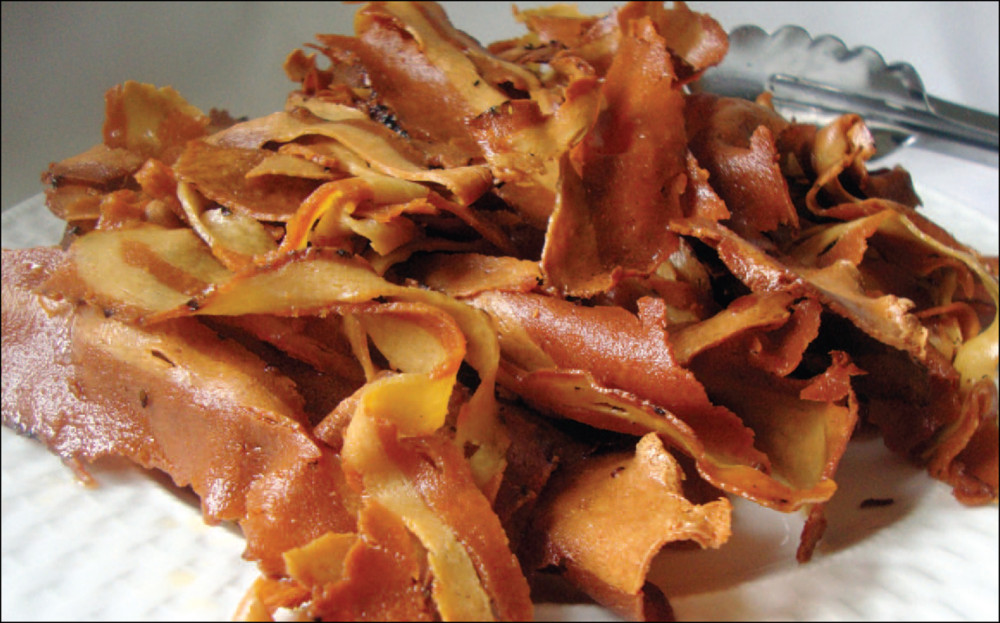
Sweet-and-Smoky Bacun
Skye Michael Conroy began his journey as a vegan chef as a hobby, but he evolved as he studied the culinary arts in depth. In 2014, he received the plant-based professional certificate of completion from Rouxbe Cooking School, taught by chef Chad Sarno.
For more information, visit the gentlechef.com.
A quantum leap in plant-based cooking!
Many vegans desire foods they can sink their teeth into—a bite with substance that leaves them feeling satisfied. Others miss the flavor of the animal-based dishes they grew up with or that were part of their cultural tradition.
Those cravings can now be put to rest. Vegan cooks everywhere are about to experience a new dimension of possibilities thanks to chef Skye Conroy’s culinary masterpiece CRAFTING SEITAN:
Creating Homemade Plant-Based Meats. With detailed instructions and mouthwatering food photography throughout, this guide is a welcome introduction to cooking seitan (aka “gluten meat” or “vital wheat gluten”) and showcasing its versatility.
Juicy roasts, tender cutlets, toothsome steaks, as well as hard salami, pepperoni, and hand-rolled sausages, , now can be part of a vegan menu. Country-style Ribz, Tandoori Chikun, Sweet-and-Smoky Bacun, and Classic Pot Roast are among the 100+ recipes. A section on seasoning blends, rubs, gravies, sauces and glazes help to add the perfect finishing touch. These recipes deliver the appearance, texture, and flavors that will convince family and friends of all dietary persuasions that a plant-based diet has plenty to offer and nothing to lose.
Homemade also means more budget-friendly meals and the ability to monitor the amount of salt and oil that’s used.
With CRAFTING SEITAN in your kitchen, you’ll always have a delicious answer ready whenever you’re asked, “Where’s the beef?”
Ingredients
Dough 1
- 5 ounces (142 g) extra-firm tofu, pressed (see page 11)
- 1 tablespoon olive oil
- 2 teaspoons garlic powder
- 1 teaspoon sea salt or kosher salt
- 1⁄2 cup water
- 1⁄2 cup vital wheat gluten
Dough 2
- 5 ounces (142 g) extra-firm tofu, pressed (see page 11)
- 6 tablespoons tamari, soy sauce, or Bragg Liquid Aminos
- 1 tablespoon hickory liquid smoke
- 1 tablespoon light brown sugar
- 1 tablespoon Worcestershire Sauce (page 182) or commercial vegan equivalent
- 4 teaspoons onion powder
- 1 tablespoon olive oil
- 1 tablespoon smoked paprika
- 1 cup vital wheat gluten
- 1⁄4 cup water
Optional Rub
- 1 teaspoon smoked black pepper or coarsely ground black pepper
- Real maple syrup or brown sugar (optional; for sweeter bacun)
Directions
- To prepare Dough 1, crumble the tofu into a food processor. Add the oil, garlic powder, salt, and 2 tablespoons of the water. Process until as smooth as possible, stopping to scrape down the sides of the work bowl as needed. Add the vital wheat gluten and the remaining water and process for 1 minute.
- Divide the dough into 2 equal pieces and set aside. There’s no need to rinse or wash the work bowl.
- To prepare Dough 2, crumble the tofu into the food processor. Add the tamari, liquid smoke, brown sugar, Worcestershire Sauce, onion powder, oil, and smoked paprika. Process until as smooth as possible, stopping to scrape down the sides of the work bowl as needed. Add the vital wheat gluten and water and process for 2 minutes. Divide the dough into 3 equal pieces and set aside.
- Lay an 18-inch-long sheet of heavy-duty aluminum foil on a work surface.
- Take a piece of Dough 2, flatten it into a disk, and place it on the foil. Repeat the process with a piece of Dough 1 and place it on top of the first disk. Repeat with the remaining pieces of dough, alternating them as you stack. Firmly press down on the stack until it is about 1 inch thick. Press and shape the dough into a compact, square slab. Don’t worry about being too precise, as the dough will expand during baking to conform to the shape of the foil package.
- If desired, season the surface of the dough with 1⁄2 teaspoon of the optional black pepper. Flip the slab over and repeat with the remaining pepper. For “candied” bacun, rub the exterior of the dough with maple syrup or pack with brown sugar.
- To wrap the dough, fold (don’t roll) the foil over the slab of bacun several times to create a flat package. Fold in the sides and crimp to seal the package.
- Wrap it in a second sheet of foil in the same manner.
If you will be oven baking the dough, leave some air space on each side of the package as the sides are folded in and crimped to allow for expansion of the dough as it bakes. Wrap it in a third sheet of foil for reinforcement. To pressure cook, put 3 cups of water in the cooker and put the trivet in place. Add the package, seal the lid, close the steam valve, and cook on high for 1 hour and 45 minutes. Turn the cooker off and let the pressure release naturally for 30 minutes. Remove the package from the cooker and let cool for 1 hour. - To oven bake (instead of pressure cook), preheat the oven to 350 degrees F (175 degrees C). Put the package directly on the middle oven rack and bake for 2 hours. Remove from the oven and let cool for 1 hour.
- To finish, refrigerate the package for 8 hours to optimize the bacun’s texture before slicing. For the best finished texture, use an electric slicer or a very sharp knife and slice the bacun as thinly as possible (unless you prefer a thicker cut).
- When sliced thin, the bacun may tatter a bit, but this only adds to the authentic finished texture and appearance.
- To oven brown the bacun, preheat the oven to 375 degrees F (190 degrees C). Line a baking sheet with aluminum foil or parchment paper and arrange the slices on it in a single layer. Generously brush the slices on both sides with cooking oil.
- Bake for 15 to 20 minutes. Transfer to a plate lined with paper towels to blot any excess oil.
- To fry the bacun, put a generous layer of cooking oil in a large skillet over medium heat (to prevent burning, avoid frying it at a high temperature). Cook until lightly browned on both sides. Transfer to a plate lined with paper towels to blot any excess oil.
- As the bacun cools, it will crisp up a bit while still retaining a chewy texture.
Recipe Note
There are several steps to this recipe, but don’t be intimidated because it’s relatively easy to prepare, and the results are well worth the effort. Two batches of dough will be mixed to create the bacun. Dough 1 is for the light marble layer and Dough 2 is for the dark marble layer. A pressure cooker is recommended for preparation; however, oven baking is an option. A food processor is required for this recipe to achieve the proper finished texture.
Tips from Chef Skye: It’s helpful to put a heavy object, such as a cast-iron skillet, on the foil package to compress it as it cools and keep the slab of bacun flat. This will also help to compress the bacun and improve its texture.

